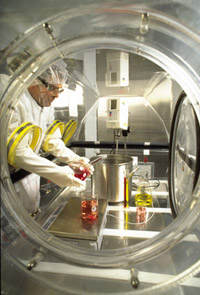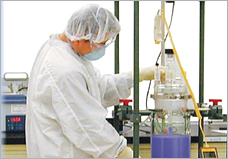|
Kill it or let it
live: it's a decision dear to the hearts of pharmaceutical
companies. The earlier a compound can be killed, or proved
ineffective, the better. Not an easy task with the avalanche of
New Chemical Entities (NCEs) in the wake of a mapped genome and
automated testing technologies. Enter formulation development,
always an important step in the drug development process, now even
more crucial to a compound's lifecycle.
As pharmaceutical companies continue to focus on R&D and
commercialization, drug development is being farmed out to
contract providers. This is nothing new; it's been happening for
years, but contract providers aren't just dealing with Big Pharma
anymore. Emerging biotech companies lack drug development
capabilities, giving more business to a burgeoning pharma and
biopharma outsourcing industry.
Having worked with pharma companies for years, the drug
development contract service providers were more than ready to
take on new business. By the late 1990s, these companies had
become experts at small molecule formulation development.
Companies that performed preformulation and regular formulation
development services could tell their clients when to "kill" a
compound and when to let it survive, offering key money- and
time-saving decisions. companies had
become experts at small molecule formulation development.
Companies that performed preformulation and regular formulation
development services could tell their clients when to "kill" a
compound and when to let it survive, offering key money- and
time-saving decisions.
New automated technologies, as well as the biotechnology industry,
have created a mountain of new drug targets waiting to be sifted
through. Now, however, in addition to small molecule drug targets,
formulation development is a puzzle that applies to large molecule
protein and peptide drug targets. This presents a whole new set of
complications never seen before.
The biggest problem facing formulation development providers is
solubility. Ask anyone in the industry, and this is the first
response. Each person contacted for this article mentioned it,
cutting me off before I could finish my question about hot topics
in formulation development. Large molecule targets are water
insoluble and formulators are working hard to tackle that problem.
Ian Smart, director of operations at Taj Pharma,
commented, "Solubility is obviously the hottest, the biggest
trend." He added, "Biotechnology companies are usually very
difficult because they tend to look at different types of
molecules. They are looking at large molecules that tend to have
solubility problems. If you've got solubility problems then it's
difficult to get that product released. That's an area we're
trying to specialize in because we've got different techniques for
helping the solubility of the product."
Elsie Melsopp, Ph.D., senior scientist, formulations division at
AAI International, commented, "These new large molecules are
predominantly water insoluble, which is a challenge. It is
difficult to do conventional preformulation studies on these
molecules and develop the right formulation for the clinic. A lot
of our clients come to us with these types of molecules."
Not only are companies trying to piece together ways of
formulating these new drug targets, but they, as always, have to
keep the regulatory issues in mind as well. The regulations for
large molecules have not been able to keep up with the speed of
discovery . "Many regulations were written with the
small molecules in mind. Some of the things you need to do with a
small molecule become much more difficult with these larger
molecules that, rather than being synthesized, are biological
products. They are purified from some fermentation source or other
biologic source. The levels and types of impurities are different,
the types of characterizations are different, the analytical
techniques are different and, sometimes, not directly amenable to
regulations written with small molecules in mind." . "Many regulations were written with the
small molecules in mind. Some of the things you need to do with a
small molecule become much more difficult with these larger
molecules that, rather than being synthesized, are biological
products. They are purified from some fermentation source or other
biologic source. The levels and types of impurities are different,
the types of characterizations are different, the analytical
techniques are different and, sometimes, not directly amenable to
regulations written with small molecules in mind."
Recently, the FDA placed the review of drugs that come from living
organisms into the same unit that handles chemical-derived
therapies. The biologics unit has lagged behind the agency's drug
unit over the years. While the agency's drug unit has halved it's
approval time over the last couple decades, the biologics segment
languished. Industry insiders are hoping this move will speed up
the approval process while making the two types of review
processes more consistent. Not an easy task. Making sure batches
are consistent is a lot easier for small molecule drugs than it is
for biologics. The biologics unit will continue to be responsible
for the regulation of vaccines and blood products.
The same rules that apply to pharmaceutical and biotech companies
also apply to contract service providers. In addition, however, a
company such as AAI not only has to follow FDA requirements, but
those of its clients as well. Service providers have to stay on
top of regulatory changes, sometimes informing their clients that
what may have passed as compliance a few years ago, may not work
today. Regulations will eventually catch up to new technology and
new molecules.
The FDA is constantly trying to keep up with innovation. New
process analytical techniques are coming from the agency to
establish online process analytical testing. Dr. Melsopp
commented, "Some companies are doing typical in-process blend and
bulk product testing, as well as on-line. In order to stay
competitive, contractors and companies have to start thinking
about process analytical technologies and to put them in place
during manufacturing."
Another hot area of formulation development is early stage
preformulation and the benefits of it. This goes back to the idea
of trying to kill compounds early. Although it may take more time
in the long run, doing some initial work can help the critical
 decision as to whether a compound goes on to the next step or not. Dr. Aggarwal said, "We've seen examples where companies haven't
done enough exploration at the initial stages of different
formulation options and therefore end up with something that dies
later in the process." decision as to whether a compound goes on to the next step or not. Dr. Aggarwal said, "We've seen examples where companies haven't
done enough exploration at the initial stages of different
formulation options and therefore end up with something that dies
later in the process."
Although the amount of preformulation done for compounds varies
from project to project, factors such as time (the most valuable
thing to drug companies) and money (the second most valuable
thing) dictate how much initial work is done. In the best of all
possible worlds, a company with ample time and money should spend
both on preformulation, according to Dr. Ingallinera.
He said, "Preformulation is where you evaluate the physical
chemical attributes of the compound before you decide what the
formulation should be. You look at it's oxygen sensitivity, where
it's pH is the most stable, solvents and co-solvent systems or
surfactants, and ways to enhance the compound's solubility or
stability. You look at whether or not the compound is extremely
water unstable and if you have to go to a dry process such as
lyophilization or powder filling in order to make the product. You
look at various methods of sterilization, and evaluate whether or
not the product can withstand the heat or the radiation or other
attributes of sterilization during preformulation. Considering
these variables at a very early stage allows you to develop a
better formulation."
Preformulation services are not the only things sponsors are
looking for from contract providers. Offering a range of services,
from preformulation to end product, cuts down on the number of
organizations that have access to a client's intellectual
property. Getting as much service as you can from one provider can
also cut down on confusion. Dr. Ingallinera commented, "Our
clients who are looking for formulation development are also
looking for the ability to manufacture and test. They like
'one-stop-shopping'."
Pharmaceuticals Products |
Diseases |
Generic Index |
Taj
Generic |
API |
Manufacturing
Pharmacological Index
|
Generic Medicines |
PDF Download |
DOC Download
Brochures Download |
API Manufacturing |
Virtual Tour of Plants
|





 companies had
become experts at small molecule formulation development.
Companies that performed preformulation and regular formulation
development services could tell their clients when to "kill" a
compound and when to let it survive, offering key money- and
time-saving decisions.
companies had
become experts at small molecule formulation development.
Companies that performed preformulation and regular formulation
development services could tell their clients when to "kill" a
compound and when to let it survive, offering key money- and
time-saving decisions. . "Many regulations were written with the
small molecules in mind. Some of the things you need to do with a
small molecule become much more difficult with these larger
molecules that, rather than being synthesized, are biological
products. They are purified from some fermentation source or other
biologic source. The levels and types of impurities are different,
the types of characterizations are different, the analytical
techniques are different and, sometimes, not directly amenable to
regulations written with small molecules in mind."
. "Many regulations were written with the
small molecules in mind. Some of the things you need to do with a
small molecule become much more difficult with these larger
molecules that, rather than being synthesized, are biological
products. They are purified from some fermentation source or other
biologic source. The levels and types of impurities are different,
the types of characterizations are different, the analytical
techniques are different and, sometimes, not directly amenable to
regulations written with small molecules in mind." decision as to whether a compound goes on to the next step or not. Dr. Aggarwal said, "We've seen examples where companies haven't
done enough exploration at the initial stages of different
formulation options and therefore end up with something that dies
later in the process."
decision as to whether a compound goes on to the next step or not. Dr. Aggarwal said, "We've seen examples where companies haven't
done enough exploration at the initial stages of different
formulation options and therefore end up with something that dies
later in the process."
